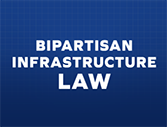Fact Sheet: Emergency Relief Program

BIPARTISAN INFRASTRUCTURE LAW FACT SHEET
PUBLIC TRANSPORTATION EMERGENCY RELIEF PROGRAM
Program Purpose:
The Bipartisan Infrastructure Law, enacted as the Infrastructure Investment and Jobs Act, continues the public transportation emergency relief program, which funds activities for protecting, repairing, and/or replacing equipment and facilities that may suffer or have suffered serious damage as a result of an emergency, including natural disasters such as floods, hurricanes, and tornadoes. Funding for this program may be appropriated by Congress as necessary.
Statutory References:
49 U.S.C. § 5324 / IIJA § 30011
Eligible Recipients:
States and local governmental authorities, including public transportation agencies.
Eligible Activities:
- Capital projects to protect, repair, reconstruct, or replace equipment and facilities of a public transportation system, including on an Indian reservation, which are in danger of suffering serious damage, or have suffered serious damage, as a result of an emergency.
- An emergency is defined as a natural disaster affecting a wide area or catastrophic failure resulting from an external cause, and as a result, the governor of a state has declared an emergency and the Secretary of Transportation has concurred, or the President has declared a major disaster.
- Operating costs related to evacuation, rescue operations, temporary public transportation service; or reestablishing, expanding, or relocating public transportation route service before, during, or after an emergency.
What’s Changed?
- Requires an applicant for emergency relief program funds to submit documentation demonstrating proof of insurance required by federal law for all structures related to the grant application, such as flood insurance required by the Flood Disaster Protection Act of 1973.
- Requires an applicant for emergency relief program funds to certify that it has insurance required by state law for all structures related to the grant application.
